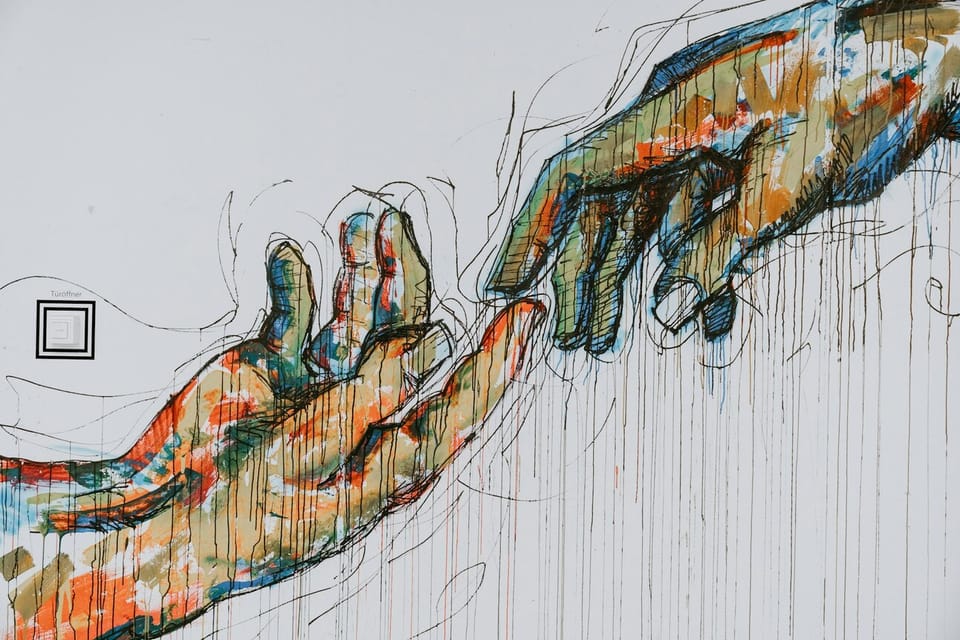A World Without Touch Is a World Without Trust

Touch is our first language. Older than words, deeper than thought. Before we can speak or remember, we understand the grammar of skin against skin; the newborn’s cry quiets at their parents' touch. This is where we all begin: not with boxes or categories, with contact.
Adult life was tactile—handshakes that lingered, embraces that meant something, the casual touch of a hand on a shoulder. We were a species comfortable in our own skin, fluent in the oldest form of communication.
But something changed. We seem to live increasingly separate, sanitized, and untouched lives. We text instead of visit. We wave instead of embrace. We nod instead of reach. Our relationships have become sterilized, distanced, disembodied. Researchers call it “touch famine” - but famine implies absence. This is something closer to erasure.
Lately, I’ve been thinking about my aunt - not by blood, but in all the ways that mattered. She hugged everyone: mailmen, baristas, strangers’ kids, sometimes to the horror of their parents. She was one of those people others found embarrassing in the way some find joy embarrassing - too much, too open, too sincere.
But she lived to 94. Rarely ill. Surrounded by people who adored her. She was never alone, and never unloved. I’m not saying touch kept her alive. But I’m not saying it didn’t. She understood something we’ve lost: that the body has its own intelligence. That warmth doesn’t always come from words. That connection isn’t just a feeling, it’s a physical act.
We didn’t grow out of touch. We were trained out of it.
And maybe it’s time to unlearn that.
How We Got Here
We could blame smartphones.
We could blame Instagram, TikTok and so on.
It's the easy answer.
But I don't think the decline in touch is entirely reducible to screen time, as tempting as that story is. It’s Technological, yes. But it's also structural. Cultural. Epidemiological. It's a slow convergence of forces that have collectively chiseled human contact out of daily life.
Start with demographics. In 1940, less than 8% of American households were single-person. Today, it’s more than a quarter. That means more people live alone, dine alone, sleep alone. No daily hugs from a spouse, no incidental affection from a roommate brushing past. Living alone doesn’t mandate touch starvation – but it makes it easier.
Then add norms. For good reasons (and some complicated ones) we’ve rewritten the rules of public and professional touch. Schools and offices now often operate under strict no-touch policies. The intentions are safety, respect, boundaries – all vital. But there’s collateral damage: positive touch disappears along with the problematic kind. For many, especially men, physical affection is now seen as risky or suspect unless it’s clearly romantic or confined to sports.
Now bring in the pandemic. COVID-19 accelerated the retreat. For a time, we were literally ordered not to touch. Social distancing became a virtue. Even when lockdowns lifted, the habits stuck. A 2022 survey found over half of Britons reported they now hugged non-household members less often. Touch didn’t just vanish – it started to feel taboo. Some of that caution remains.
And all of this happens in a digital context that rewards disembodiment. We text. We video call. We "React." Our communication is abundant, but our contact is vanishingly rare.
The Body Keeps the Score
So what? Does a little less hugging really matter?
Yes. The research is overwhelming. Touch is not optional. It’s not sentimental fluff. It’s biological infrastructure. We’re wired for it.
Affectionate touch – a hug, a handhold, a shoulder squeeze – triggers cascades of neurochemical effects. Oxytocin rises. Cortisol drops. The parasympathetic nervous system kicks in. Stress eases. Blood pressure falls. The heart rate slows. These are not trivial physiological shifts - they’re indicators of regulatory balance, the body’s way of keeping itself in check.
Without touch, the body loses one of its primary stress buffers. People deprived of touch show higher cortisol, weaker immune responses, elevated pain sensitivity, and greater incidence of anxiety and depression. In one study, patients receiving massage therapy showed increased levels of natural killer cells - crucial for immune defense. In another, premature infants who received gentle stroking gained weight faster and had fewer complications.
Touch is an immune intervention. A neuroendocrine regulator. A developmental requirement.
And it changes behavior. Children who grow up with more affectionate contact show better emotional regulation and less aggression. Adolescents who receive positive touch are more socially confident. Adults in touch-deprived relationships report higher stress and lower satisfaction. In every stage of life, touch functions as both a physiological stabilizer and a social signal.
Its absence is not neutral.
Cultural Calibration
Not all societies touch equally. Anthropologists have long classified cultures as “contact” and “non-contact” based on norms of proximity and touch. Latin America, Southern Europe, the Middle East – these are high-touch zones. Northern Europe, East Asia, the Anglosphere – lower-touch.
A study by Dr. Tiffany Field of the Touch Research Institute observed teens in Paris and Miami hanging out with friends. The French teens touched each other—playful pushes, shoulder nudges, light embraces—nearly 180 times in an hour. The Americans? Less than 20. And with far more instances of verbal aggression.